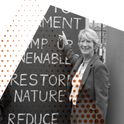
Find Prospect's full report, "The Future of Energy" here
In January 2017 the US National Aeronautics and Space Administration (Nasa) announced that independent analyses it conducted with the National Oceanic and Atmospheric Administration (Noaa) showed that 2016 was the Earth’s warmest year on record and represented the third record year in a row.
The release noted that the rise in temperature is being driven primarily by increased carbon dioxide and other greenhouse gas emissions resulting from human activity. According to the Environmental Protection Agency (EPA), the largest sources for greenhouse gas emissions in the United States are electricity production and energy use within industries.
At HP, we believe that efforts to reduce energy use and lower greenhouse gas emissions across our technology portfolio, operations and supply chain are critical to our long-term business sustainability and our customers’ success. We know that electricity consumption represents approximately 62 per cent of the greenhouse gas emissions associated with the use of our products. So improving the energy efficiency of those products can help reduce their environmental impact and lower our customers’ operating costs.
Product energy efficiency is a critically important parameter that drives HP’s research and development activities and supports our Design for the Environment (DfE) programme. Founded in 1992, the programme guides every aspect of product design and development, including efforts to reduce power consumption.
The efforts have certainly paid off. In fact, since 2010, on average we have reduced the energy consumption of our personal system portfolio by 34 per cent, and seen reductions of 56 per cent and 20 per cent in our LaserJet and inkjet portfolios respectively. And we continue to improve the energy efficiency of our product portfolio, without making trade-offs on the design, quality, performance or reliability our customers demand.
As examples, the HP Elite Slice desktop computer consumes 50 per cent less energy than a comparable small form factor desktop and the new HP Z2 Mini G3 Workstation is a thinner and lighter system than traditional small form factor workstations and desktops—and it too is up to 71 per cent more energy efficient.
Our design teams bring the same innovative spirit to improving the efficiency of our printing products. HP PageWide Technology represents one of those innovations—delivering groundbreaking improvements in the materials and energy efficiency of business, large-format, and web press printers. At the core of this technology is a page-width print head, which remains stationary while printing and prints entire pages in a single pass. According to a third-party analysis, business printers using this technology use at least 98 per cent less energy than comparable laser printers.
We also extend energy efficiency with our service-based solutions, such as Managed Print Services, which is designed to help customers optimise, manage, and improve their printer fleets and digital workflows. This solution also reduces printing-related energy usage by up to 40 per cent, while decreasing imaging and printing costs by up to 30 per cent.
While our products account for the majority of our carbon footprint, we also take action to improve energy efficiencies across our operations and supply chain and to shift to less Greenhouse gas-intensive energy sources. One innovation was the implementation of a smart building project in Houston, Texas, which will have estimated savings of 1.2m kilowatt hours (kWh) of energy per year.
Our commitment is reflected in a pledge we made in 2016 to achieve 100 per cent renewable electricity usage in our global operations. And it is supported by a new commitment we made in February 2017 to reduce the Greenhouse gas emissions from our global operations by 25 per cent by 2025, compared to 2015 levels.
Within our supply chain, we partner with BSR, WWF China and the World Resources Institute, to bring the Energy Efficiency Programme to suppliers in China and Southeast Asia. The programme promotes energy efficiency initiatives and enables suppliers to share best practices for achieving energy efficiency improvements. The programme has already helped more than 200 supplier sites cumulatively save more than 500m kWh of electricity and an estimated $73m.
At HP, we believe that our actions can positively impact how we, our customers, and our partners do business. Through the efforts of our employees and partners, we are reinventing the way that our products work and our operations and supply chain are run to be more energy efficient—and ultimately—create a more sustainable world.

You can also receive the full report as a fully designed PDF document by simply entering your email below.
[prosform fields="email,forename,surname" signupcode="Energy" countrycode="GB" redirect="the-future-of-energy-is-yours"]
When you sign up for this free report, you will also join our free Prospect newsletter.
Prospect takes your privacy seriously. We promise never to rent or sell your e-mail address to any third party. You can unsubscribe from the Prospect newsletter at any time













